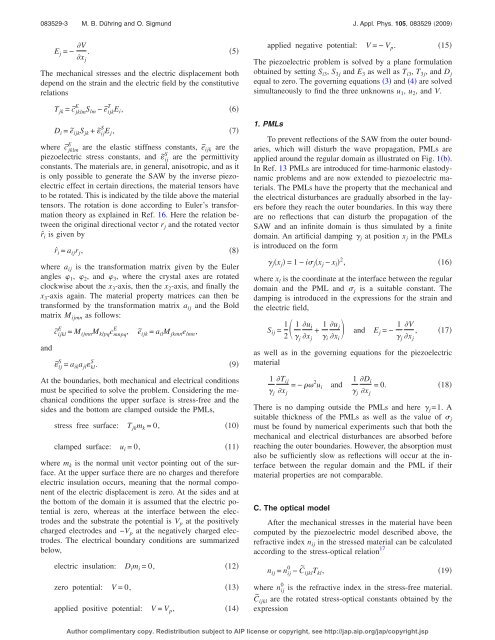Maria Bayard Dühring - Solid Mechanics
Maria Bayard Dühring - Solid Mechanics
Maria Bayard Dühring - Solid Mechanics
You also want an ePaper? Increase the reach of your titles
YUMPU automatically turns print PDFs into web optimized ePapers that Google loves.
083529-3 M. B. <strong>Dühring</strong> and O. Sigmund J. Appl. Phys. 105, 083529 2009<br />
Ej =− V<br />
. 5<br />
x j<br />
The mechanical stresses and the electric displacement both<br />
depend on the strain and the electric field by the constitutive<br />
relations<br />
E T<br />
Tjk = c˜ jklmSlm<br />
− e˜ ijkEi,<br />
6<br />
S<br />
Di = e˜ ijkSjk + ˜ ijEj,<br />
7<br />
E<br />
where c˜ jklm are the elastic stiffness constants, e˜ ijk are the<br />
S<br />
piezoelectric stress constants, and ˜ ij are the permittivity<br />
constants. The materials are, in general, anisotropic, and as it<br />
is only possible to generate the SAW by the inverse piezoelectric<br />
effect in certain directions, the material tensors have<br />
to be rotated. This is indicated by the tilde above the material<br />
tensors. The rotation is done according to Euler’s transformation<br />
theory as explained in Ref. 16. Here the relation between<br />
the original directional vector rj and the rotated vector<br />
rˆ i is given by<br />
rˆ i = a ijr j, 8<br />
where a ij is the transformation matrix given by the Euler<br />
angles 1, 2, and 3, where the crystal axes are rotated<br />
clockwise about the x 3-axis, then the x 2-axis, and finally the<br />
x 3-axis again. The material property matrices can then be<br />
transformed by the transformation matrix a ij and the Bold<br />
matrix M ijmn as follows:<br />
and<br />
E E<br />
c˜ ijkl=<br />
MijmnMklpqcmnpq , e˜ ijk = a ilM jkmne lmn,<br />
S S<br />
˜ ij = aikajlkl. 9<br />
At the boundaries, both mechanical and electrical conditions<br />
must be specified to solve the problem. Considering the mechanical<br />
conditions the upper surface is stress-free and the<br />
sides and the bottom are clamped outside the PMLs,<br />
stress free surface: T jkm k =0, 10<br />
clamped surface: u i =0, 11<br />
where m k is the normal unit vector pointing out of the surface.<br />
At the upper surface there are no charges and therefore<br />
electric insulation occurs, meaning that the normal component<br />
of the electric displacement is zero. At the sides and at<br />
the bottom of the domain it is assumed that the electric potential<br />
is zero, whereas at the interface between the electrodes<br />
and the substrate the potential is V p at the positively<br />
charged electrodes and −V p at the negatively charged electrodes.<br />
The electrical boundary conditions are summarized<br />
below,<br />
electric insulation: D im i =0, 12<br />
zero potential: V =0, 13<br />
applied positive potential: V = V p, 14<br />
applied negative potential: V =−V p. 15<br />
The piezoelectric problem is solved by a plane formulation<br />
obtained by setting S i3, S 3j and E 3 as well as T i3, T 3j, and D j<br />
equal to zero. The governing equations 3 and 4 are solved<br />
simultaneously to find the three unknowns u 1, u 2, and V.<br />
1. PMLs<br />
To prevent reflections of the SAW from the outer boundaries,<br />
which will disturb the wave propagation, PMLs are<br />
applied around the regular domain as illustrated on Fig. 1b.<br />
In Ref. 13 PMLs are introduced for time-harmonic elastodynamic<br />
problems and are now extended to piezoelectric materials.<br />
The PMLs have the property that the mechanical and<br />
the electrical disturbances are gradually absorbed in the layers<br />
before they reach the outer boundaries. In this way there<br />
are no reflections that can disturb the propagation of the<br />
SAW and an infinite domain is thus simulated by a finite<br />
domain. An artificial damping j at position x j in the PMLs<br />
is introduced on the form<br />
jx j =1−i jx j − x l 2 , 16<br />
where x l is the coordinate at the interface between the regular<br />
domain and the PML and j is a suitable constant. The<br />
damping is introduced in the expressions for the strain and<br />
the electric field,<br />
Sij = 1<br />
2 1 ui +<br />
j x j<br />
1 u j<br />
and Ej =−<br />
i xi 1 V<br />
, 17<br />
j x j<br />
as well as in the governing equations for the piezoelectric<br />
material<br />
1 Tij x j<br />
1 Di =−<br />
j 2ui and =0. 18<br />
j x j<br />
There is no damping outside the PMLs and here j=1. A<br />
suitable thickness of the PMLs as well as the value of j must be found by numerical experiments such that both the<br />
mechanical and electrical disturbances are absorbed before<br />
reaching the outer boundaries. However, the absorption must<br />
also be sufficiently slow as reflections will occur at the interface<br />
between the regular domain and the PML if their<br />
material properties are not comparable.<br />
C. The optical model<br />
After the mechanical stresses in the material have been<br />
computed by the piezoelectric model described above, the<br />
refractive index n ij in the stressed material can be calculated<br />
according to the stress-optical relation 17<br />
0<br />
nij = nij − C˜ ijklTkl, 19<br />
0<br />
where nij is the refractive index in the stress-free material.<br />
C˜ ijkl are the rotated stress-optical constants obtained by the<br />
expression<br />
Author complimentary copy. Redistribution subject to AIP license or copyright, see http://jap.aip.org/jap/copyright.jsp
















